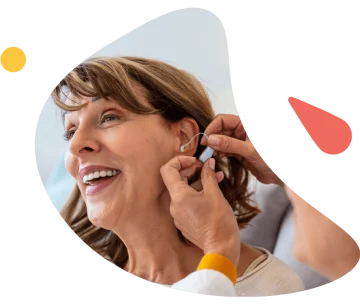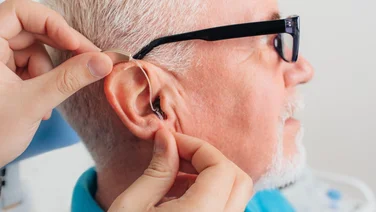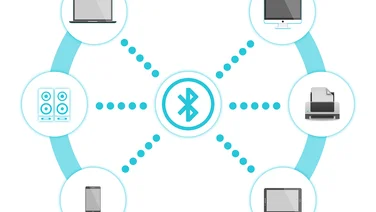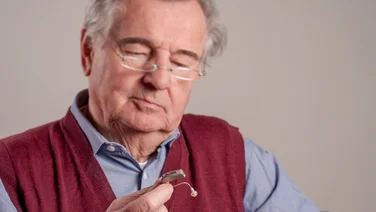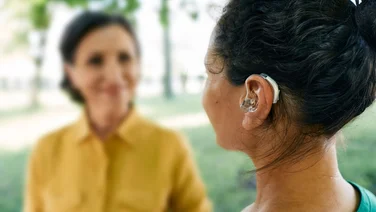If you’re experiencing hearing loss and have been advised that you’d benefit from wearing a hearing aid, you might be wondering where to start.
The subject of hearing aids can be a minefield because there are so many different hearing aid types to choose from. You may find it to be difficult to select the best hearing aid for you.
We’re here to help you navigate your way through the different hearing aid options. The information is intended as a guide and does not substitute the advice of a qualified hearing professional.
Remember that your own hearing loss, circumstances, and preferences are individual to you, so always talk to your audiologist before selecting hearing aids.
What is the best hearing aid?
There is no one-size-fits-all when it comes to hearing aids. What works well for someone else may not be suitable for you. So, the best hearing aid will vary entirely from person to person.
Narrow down the options according to your individual circumstances when deciding what hearing aids to purchase, which will includes the type and degree of hearing loss you have, and what’s most important to you.
Below are the most common hearing aid styles:
What you need to consider when buying hearing aids
If you have severe or profound hearing loss, the smallest types of in the ear hearing aids, such as completely in the canal (CIC) and invisible in canal (IIC, or invisible hearing aids), won’t improve your hearing.
On the other hand, if you are conscious about having a hearing aid that’s visible when you wear it – and if your hearing loss isn’t very bad – then you’ll want to avoid the traditional behind the ear hearing aid.
With all this in mind, below is a selection of the hearing aids that meet different criteria and preferences.
Best hearing aids for mild hearing loss
Many people are put off from the idea of using a hearing aid because they don’t want to wear a bulky, plastic device behind their ear that’s noticeable and may draw attention to the fact they have hearing loss.
Behind the ear hearing aids are now available in smaller, sleeker, and more sophisticated styles. However, you might still prefer something more discreet.
If your hearing loss is mild, it is likely that you’ll have the option of a hearing aid that is so small you can barely see it at all. A completely in canal (CIC) or an invisible in canal (IIC) hearing aid fits the bill.
CIC and invisible hearing aids house all the components in a tiny case that’s small enough to sit in your ear canal. As the size and shape of each person’s canals are different, these hearing aids will be custom-made.
The difference between CIC and invisible hearing aids is the size and the depth at which they can be positioned within your your ear canal. A CIC aid might be slightly visible when you’re wearing it, but an IIC isn’t.
Both types may be too small to accommodate lots of features, but speak to your audiologist or hearing aid provider to find out what options are available.
Best hearing aids for severe hearing loss
If you’ve been told your hearing loss range – how loud sound needs to be for you to hear it – is 71 dBHL or more, you have severe hearing loss. If your range is 91 dBHL or more, your hearing loss is profound.
Severe hearing loss means you probably can’t hear the phone or doorbell ringing, the sound of traffic, or a vacuum cleaner being used.
With profound hearing loss, you may not hear very much at all – even the noise of airplanes and firearms.
All this means that your hearing aid options are limited, because many types of hearing aids won’t provide sufficient amplification to improve your hearing.
Hearing aids for very severe or profound hearing loss are called ‘power’ or ‘superpower’ hearing aids. They are behind-the-ear (BTE) hearing aids – the traditional style most people think of when they imagine a hearing aid.
BTE hearing aids hook over the top of your ear, and the casing that contains the electrical components rests behind your ear.
With power hearing aids, the case (the aid itself) tends to be a little larger than other types of BTE aids because it contains a lot of circuitry to produce powerful sound.
However, this doesn’t necessarily mean all power aids are bulky and obtrusive. The advancement in technology has enabled some manufacturers to make smaller, less obvious power aids.
The added benefits of power hearing aids are that they can often be fitted with extra features to improve your hearing experience.
These include rechargeable batteries; feedback minimization; bespoke programming to bring harder-to-hear sounds into an audible range; and telecoils, which link to hearing loop systems in large venues and help you hear better in those public spaces.If your hearing is starting to bother you, or is gradually declining, it’s always worth speaking to an expert. We can connect you with a local audiologist to get you the help you need. Fill in our quick form and we’ll do the rest.
Best hearing aids if you’re prone to ear wax
Some people will naturally produce more earwax than others, and if you wear hearing aids you may find that wax builds up. It will inevitably affect how well your hearing aid works.
The good news is that if your hearing loss is mild to moderate, you may be able to use a hearing aid that can minimize the problem of earwax by design.
A receiver in the canal (RIC) hearing aid is likely do the best job.
This is a type of behind the ear hearing aid, which means the microphone and amplifier are housed in a small case that hooks over the top of your ear and tucks in behind it.
The receiver (or speaker) is contained in a flexible, bell-shaped tip (a dome) that is connected to the hearing aid by a very thin tube. The dome is sits in your ear canal, so onlookers can’t see it.
An RIC aid is often called an open-fit hearing aid because its placement allows the ear canal to remain open, so air can flow through naturally.
As the ear canal isn’t blocked, ear wax can naturally move up through and out of the ear, reducing a wax build-up over time.
RIC hearing aids have wax guards or wax filters under the dome that are attached to the receiver, preventing the wax from damaging the hearing aid. Ask your audiologist or hearing aid provider about this option.
Whichever type of hearing aid you use, you can minimize the impact of ear wax on your hearing aids by regularly cleaning your ears and your hearing aids.
Other than your hearing aids, and any tools and equipment your audiologist may use to examine your ears, you should never put anything inside your ear – including q-tips, cotton buds, or any other device that claims to remove ear wax.
Best cheap hearing aids
Price will almost always be a deciding factor when choosing hearing aids. You might be tempted to go for the cheapest hearing aids available, but it’s not quite that simple.
First of all, some factors will restrict your options from the start. For instance, BTE hearing aids can be worn by most people for all types of hearing loss, but they are usually for people with severe or profound hearing loss.
All major hearing aid manufacturers have different ranges for different budgets. So, if cost is the main influencer, you may be limited to lower-end or mid-range options.
This could mean sacrificing features and add-ons that are available with more advanced and higher-priced hearing aids. You might also find that lower-priced hearing aids are not as comfortable to wear.
Depending on your circumstances if you live in the US, you might be eligible for financial assistance to help you buy and maintain your hearing aids.
It’s worth checking if you qualify for Medicaid or support from other state agencies, and if there are hearing aid banks or similar programs in your area. If you’re a veteran with noise-induced hearing loss, you might be able to access rehabilitative services through the US Department of Veterans Affairs.
If you live in the UK, you can get hearing aids on the NHS, which means you won’t have to pay for them.
In most cases, batteries and repairs are carried out at no cost to you, but you might need to contribute if you lose or break your hearing aid. Aftercare is usually included, too.
It’s worth noting that the NHS buys hearing aids from the same manufacturers as you would buy them from privately.
Other than cost, the main difference with NHS hearing aids is that there tends to be far less choice, and you’ll probably be limited to behind the ear hearing aids. And, like with any NHS service, you might have to wait longer for a hearing assessment and for your hearing aids to be made.
Paying privately for hearing aids will open up more choice, but you should also think about what you will get for your money.
Whatever your type and degree of hearing loss, and your lifestyle and preferences, you should always talk to your audiologist or hearing professional for advice before buying a hearing aid.
When it comes to the crunch and you’re ready to make a purchase, do your homework and shop around.
Taking those steps will make it easier to find the best hearing aid for you.
